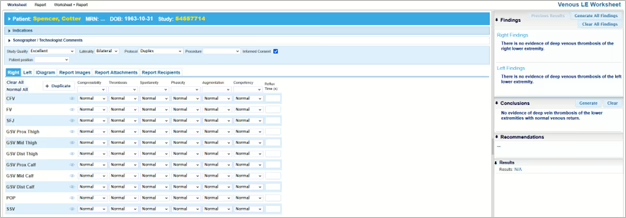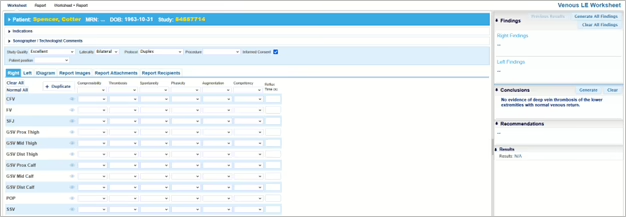Worksheet Configuration
Studycast My Choices Forms let you customize both the appearance and functionality of your worksheets to suit your specific needs. By using these forms, you can tailor forms to align with your workflow preferences. These allow for greater flexibility, enabling you to enhance organization, improve accuracy, and streamline reporting by choosing only what is relevant to your workflow. Whether modifying findings, observation, and conclusion statements, selecting preferred report layouts, or choosing your needed fields, configuring your worksheet lets you create a personalized experience that enhances productivity and supports high-quality patient care.
Normal vs. Blank
When an observation has a value, it means a findings statement is generated. Observations in worksheets can be automatically set to “Normal” or blank, depending on your preference. Selecting “Normal” means a normal statement is generated, for example “There is no evidence of deep vein thrombosis of the right lower extremity” in the Venous LE worksheet. If you set an observation value to “Blank” it means no statement is generated for that observation.
Studycast default values are designed so that your new worksheet already contains findings statements for a “Normal” exam so that the technologist or interpreting physicians only needs to document abnormalities, reducing the work to create a report.

Normal observations and findings

Blank observations and findings
In addition to normal and blank values, Studycast support can set defaults for your worksheet to any values you need. For more information, see: Step by Step: Setting Worksheet Default Values.
References and Criteria
Many worksheets allow you to select specific references or criteria to guide their observations, ensuring reports align with preferred standards and clinical guidelines. For example, in vascular studies, you can choose from different stenosis criteria, such as Hodgkiss-Harlow or Moneta, to define severity thresholds based on institutional preferences. Or in obstetric worksheets, you can select your desired fetal anatomy references to ensure measurements and assessments follow the proper developmental standards. This flexibility enhances accuracy, consistency, and compliance with best practices.

Example criteria choices
Worksheet-Specific Options
Many worksheets also include various worksheet-specific options to enhance reporting and personalized configuration.
For example:
- In the Echo worksheet, you can enable Studycast Advisor, which provides suggestions based on published guidelines, triggering only when selected observations do not align with standard recommendations.
- In the Obstetric worksheet, choose if or which growth charts can automatically appear on reports or can be manually toggled on when necessary.
- In the Nuclear Cardiac worksheet, choose between a standard 17-segment or an optional 20-segment diagram for both Function and Perfusion diagrams.
These are just some of the options available. Each worksheet has specific options allowing you to configure them to fit your specific needs.
For more information about the options available for a specific worksheet, contact Studycast support or schedule training with a member of our team.
